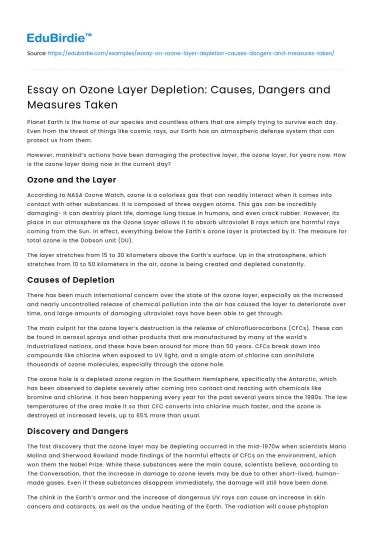Planet Earth is the home of our species and countless others that are simply trying to survive each day. Even from the threat of things like cosmic rays, our Earth has an atmospheric defense system that can protect us from them.
However, mankind’s actions have been damaging the protective layer, the ozone layer, for years now. How is the ozone layer doing now in the current day?
Save your time!
We can take care of your essay
- Proper editing and formatting
- Free revision, title page, and bibliography
- Flexible prices and money-back guarantee
Ozone and the Layer
According to NASA Ozone Watch, ozone is a colorless gas that can readily interact when it comes into contact with other substances. It is composed of three oxygen atoms. This gas can be incredibly damaging- it can destroy plant life, damage lung tissue in humans, and even crack rubber. However, its place in our atmosphere as the Ozone Layer allows it to absorb ultraviolet B rays which are harmful rays coming from the Sun. In effect, everything below the Earth’s ozone layer is protected by it. The measure for total ozone is the Dobson unit (DU).
The layer stretches from 15 to 30 kilometers above the Earth’s surface. Up in the stratosphere, which stretches from 10 to 50 kilometers in the air, ozone is being created and depleted constantly.
Causes of Depletion
There has been much international concern over the state of the ozone layer, especially as the increased and nearly uncontrolled release of chemical pollution into the air has caused the layer to deteriorate over time, and large amounts of damaging ultraviolet rays have been able to get through.
The main culprit for the ozone layer’s destruction is the release of chlorofluorocarbons (CFCs). These can be found in aerosol sprays and other products that are manufactured by many of the world’s industrialized nations, and these have been around for more than 50 years. CFCs break down into compounds like chlorine when exposed to UV light, and a single atom of chlorine can annihilate thousands of ozone molecules, especially through the ozone hole.
The ozone hole is a depleted ozone region in the Southern Hemisphere, specifically the Antarctic, which has been observed to deplete severely after coming into contact and reacting with chemicals like bromine and chlorine. It has been happening every year for the past several years since the 1980s. The low temperatures of the area make it so that CFC converts into chlorine much faster, and the ozone is destroyed at increased levels, up to 65% more than usual.
Discovery and Dangers
The first discovery that the ozone layer may be depleting occurred in the mid-1970w when scientists Mario Molina and Sherwood Rowland made findings of the harmful effects of CFCs on the environment, which won them the Nobel Prize. While these substances were the main cause, scientists believe, according to The Conversation, that the increase in damage to ozone levels may be due to other short-lived, human-made gases. Even if these substances disappear immediately, the damage will still have been done.
The chink in the Earth’s armor and the increase of dangerous UV rays can cause an increase in skin cancers and cataracts, as well as the undue heating of the Earth. The radiation will cause phytoplankton to inhibit their reproductive cycle, as explained by National Geographic. As the bottom members of the food chain, their decrease would inevitably decrease the populations of the animals in the upper echelons of the chain as well, and this would then go all the way up to affect our own species. In fact, scientists have already found evidence of the reduction of fish, crab, frog, and shrimp populations from overexposure to UV rays.
Measures Taken and Eventual Fate
Most of the world’s CFCs, about 90%, have come from the activities of Northern Hemisphere countries such as the US and those in Europe. However, while the ozone has been severely damaged in recent decades, scientists have found that the ozone layer can repair itself. After CFC use was banned in 1996, chlorine levels in the atmosphere began to lower. From there, they estimated that it would take about 50 years for the chlorine to reach normal levels. The UN released a report that the ozone layer was on track to heal after half a century.
Aside from the CFC ban in 1996, an earlier treaty, called the Montreal Protocol, was done in 1989 that prohibited the use of ozone-depleting chemicals in products. About 45 countries signed this treaty, and it was later ratified by 197 nations. Though this treaty came into effect a long time ago, ozone levels were still decreasing after the fact. This prompted leaders to double down on other substances like the ones that released greenhouse gases, such as hydrofluorocarbons.
There is still much unknown about the ozone layer and what can affect it other than UV rays and CFCs. Further research into harmful substances and better strategies for helping the ozone layer restore itself may come within the next few years. For now, we must all do our part in helping save the ozone layer.






 Stuck on your essay?
Stuck on your essay?

